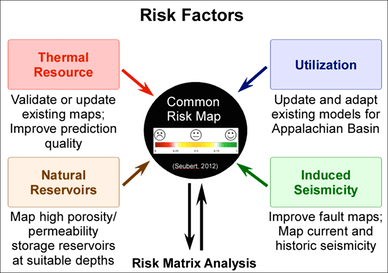Cornell’s Climate Action Plan explored the idea of deep direct use heat for low temperature applications, since early 2009. Over time, the idea developed into the present Earth Source Heat project, a term coined in the Climate Action Plan of 2016. ESH is one of the main solutions outlined by the working group that has the potential to achieve Cornell’s 2035 carbon neutrality goal.

Concurrently, the Cornell team, with collaborators from West Virginia University and Southern Methodist University’s Geothermal Lab, conducted a play fairway analysis (PFA) of direct use geothermal plays in the Appalachian Basin portions of New York, Pennsylvania and West Virginia. The analysis, funded by the Department of Energy, used pre-existing data from a lengthy history of national and state regulatory and research efforts. PFA techniques, pioneered by the hydrocarbon industry, assign risk metrics that communicate the favorability of a potential resource-bearing reservoir in order to enable prudent allocation of resources. Attributes considered in the study include: 1) thermal resource quality, 2) natural reservoir quality, 3) risk of induced seismicity, and 4) utilization opportunities.

Results concluded that the Appalachian Basin is indeed a low temperature geothermal resource with useable temperature for district heating ranging from 60 to 120°C. Several areas within the region have higher grade resources called “plays”. Plays are subdivided into inner and outer plays based on relative favorability of the four attributes (“high priority” and “medium priority” zones). In the Corning-Ithaca Play, parts of Tompkins County fall within high priority zones.
Nevertheless, the favorability of the Cornell region has been calculated based on spatially scattered data that omit information vital to geothermal heat. That is very different that the vital documentation that deep-sourced geothermal energy can be extracted economically, environmentally, and safely at any specific location. Hence Cornell’s geoscientists and engineers are engaged in research focused on our home base, central Tompkins County, to discover the feasibility of Earth Source Heat.
Publications
Click this link to see all publications.
